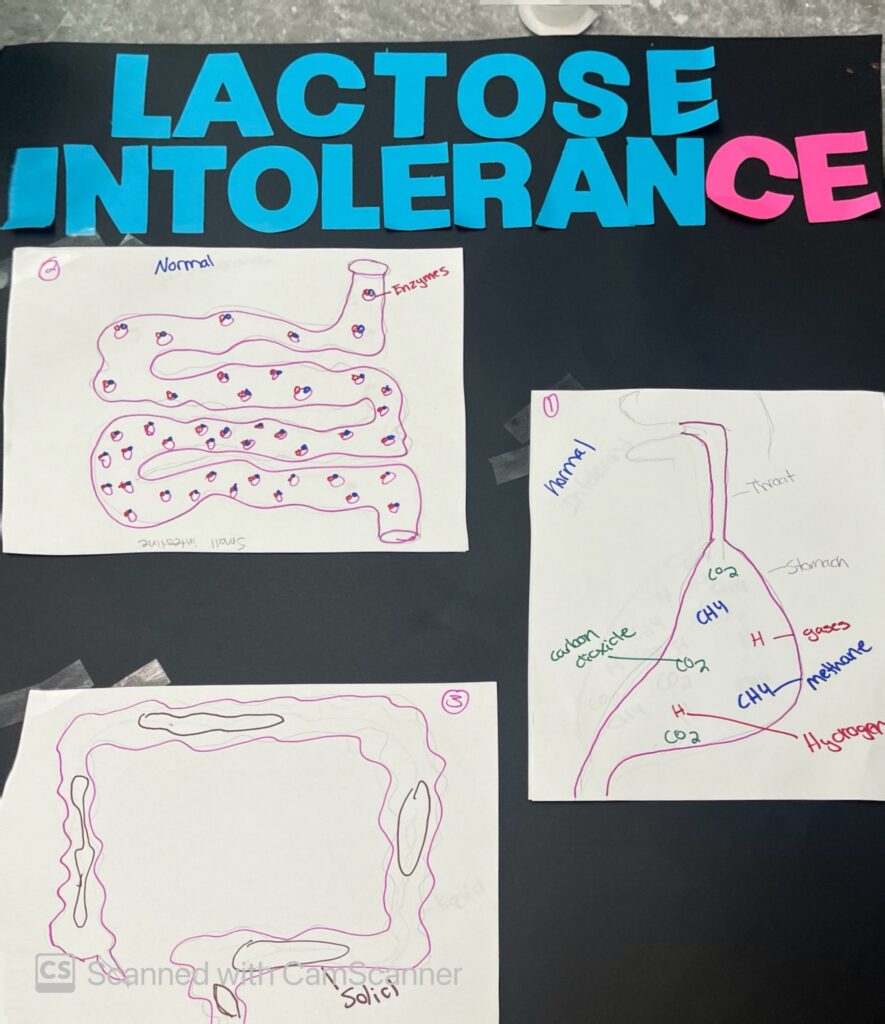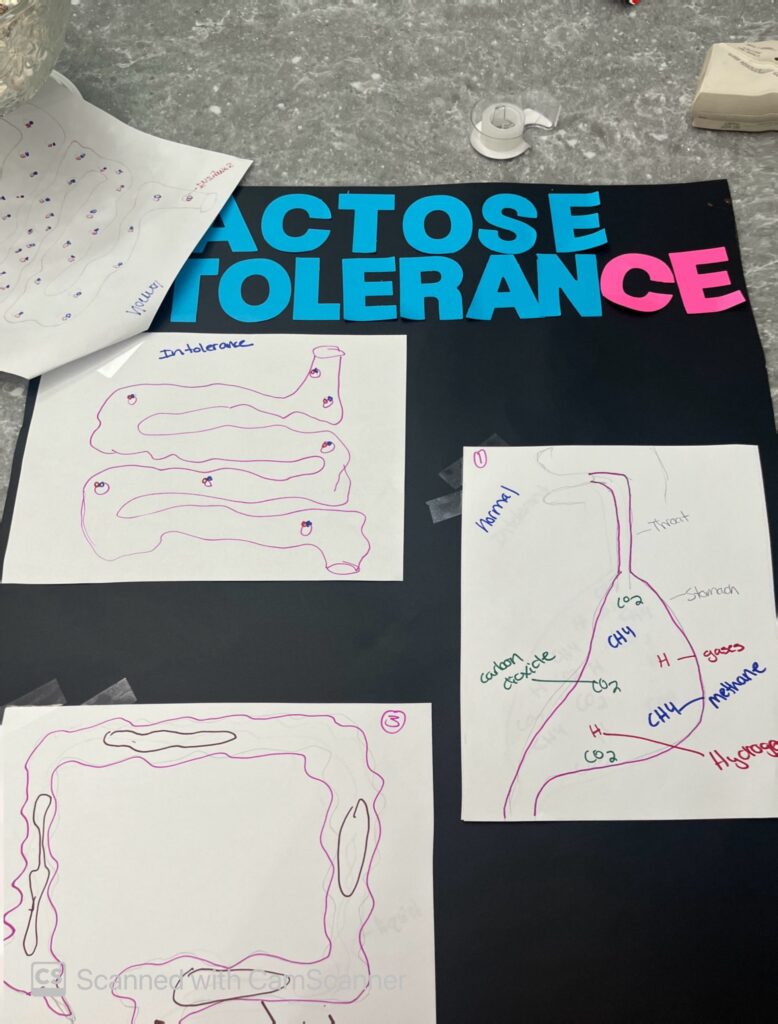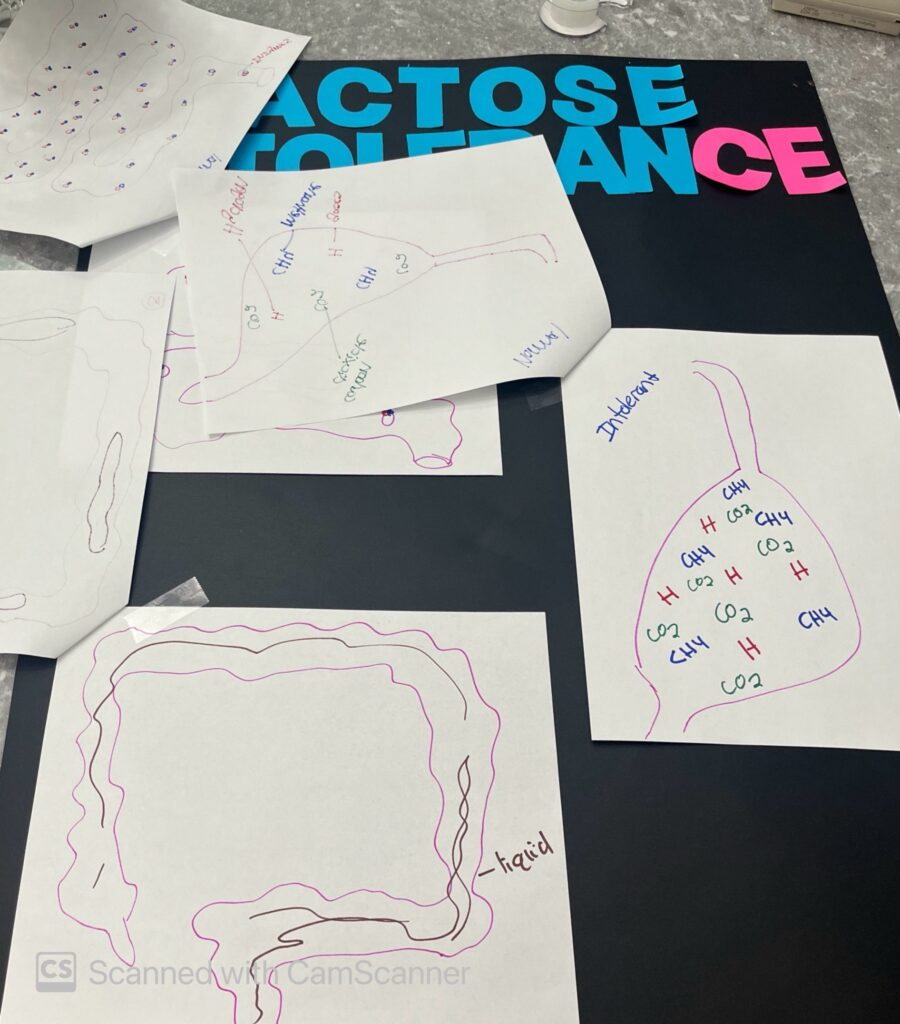Steam project
This semester I chose to focus on lactose intolerance and what it does to different digestive organs. This directly relates to the learning objective of knowing the functions of digestive organs and the course food runs through the digestive system. I decided to make a poster displaying different organs in the digestive system. On the poster I did like a flip page so you can see the difference between people who don’t have intolerance and people who do. So I will explain in this paper what lactose intolerance is, what organs I decided to include on my poster why they are important, and treatments that help the symptoms of lactose intolerance.
Start with basic information about lactose intolerance. Lactose intolerance happens because, in our small intestines, normal intestines produce an enzyme called enzyme lactase that breaks down the sugar lactose in milk or dairy products. People who have this intolerance don’t produce enough or any of those enzymes to break down the sugar lactose in milk. So instead of it being broken down it sits in the gut until bacteria breaks it down enough. Because of this process where all of the symptoms come from. According to Hopkins Medicine, the symptoms of lactose intolerance include abdominal cramps/pain, nausea, bloating, gas, and diarrhea. Depending on how severe your symptoms would be would be based on how much dairy product you had or how much lactase your body creates.
According to BMC, a journalist article 70% of the adult population has a limited amount of the lactase enzyme with a wide variation among different regions and countries. The main organ that is involved in this intolerance is the small intestine. In the pictures I drew I made two small intestines the top page is the normal intestine and the bottom is the intolerant one. The normal one has plenty of enzymes to break down that sugar and the other has very few. In my picture, I drew little enzymes that have two parts. The main circle of it that is pink is the enzyme itself and the two color circles are substrate that gets realized into two products that go and break down things. So then because the enzymes aren’t there to break it down it sits there and as the bacteria are breaking down the sugars it creates gas. The gas goes up into the stomach causing the body to bloat. In my project, I made two stomachs a smaller one and a bigger one. The bigger one is the intolerant one because when those gasses go up and fill the stomach it causes the stomach to become bloated and uncomfortable. So in my drawing, the intolerant one has a whole bunch of the gases and the normal one has a few normal amounts. Lastly, the large intestine is where we absorb water and nutrients in the feces to then discharge it. Normally the stool would move through getting solid and coming out in a solid fece. When you eat or drink milk products as someone who is lactose intolerant the lactose just sits in the gut and doesnt get digested. Since our body tries to digest it with bacteria and can’t the body wants it out of the system making it go through the digestive system faster. So when it gets to the large intestine it doesnt have time to absorb the water and liquids it just comes right out. On my poster, I drew a large intestine with solid feces and then another one with liquid feces. These symptoms can change depending on your body and the amount of dairy.
Lastly, what can people do to treat this so they can enjoy a nice cup of chocolate milk? There arent really any medicines that can cure lactuse intolerance but there are pills or droplets that you take before you consume dairy to help your gut by replacing those enzymes the body isnt producing enough of. This is just a short term solution to lactose intolerance but can help with not having symptoms of the intolerance. There are no long term treatments to help with lactose intolerance so the best idea is to have a good idet to manage it. Cutting ot diary products or swapping them with lactose free substitutes instead will save you a lot of pain. According to the national library of medicine intrdocuing good yogurts into the diet first would be best option. Then testing different dairy products to see what products create worse symptoms or not so bad. This way you know what does what to your body. Learning and adapting to what your body needs will be the key to living with the intolerance.
Having a lactose intolerance is not a deathly situation but can highly ruin your day. Lactose intolerance comes from not having enough of the lactase enzyme to break down the sugar in the dairy products. Different symptoms come from different organs and people with normal verus intolarant had different things going on in theri organs in the digestive system. With all of this there is no long term solution to this but their are ways to change your life to live more comfortably.
Works cited
Szilagyi, A., & Ishayek, N. (2018, December 15). Lactose intolerance, dairy avoidance, and treatment options. Nutrients. https://www.ncbi.nlm.nih.gov/pmc/articles/PMC6316316/
Lactose intolerance. Johns Hopkins Medicine. (n.d.). https://www.hopkinsmedicine.org/health/conditions-and-diseases/lactose-intolerance
Facioni, M. S., Raspini, B., Pivari, F., Dogliotti, E., & Cena, H. (2020, June 26). Nutritional management of lactose intolerance: The importance of Diet and food labelling – journal of translational medicine. BioMed Central. https://translational-medicine.biomedcentral.com/articles/10.1186/s12967-020-02429-2




